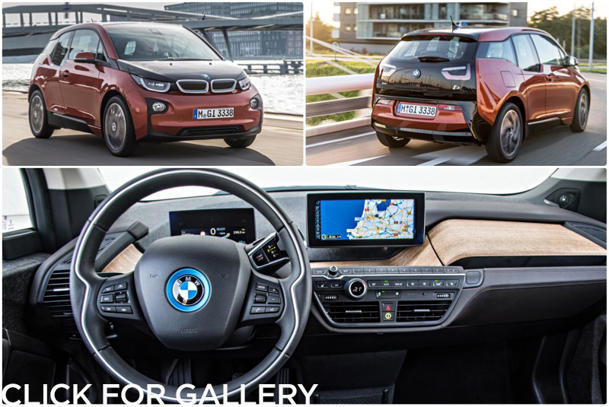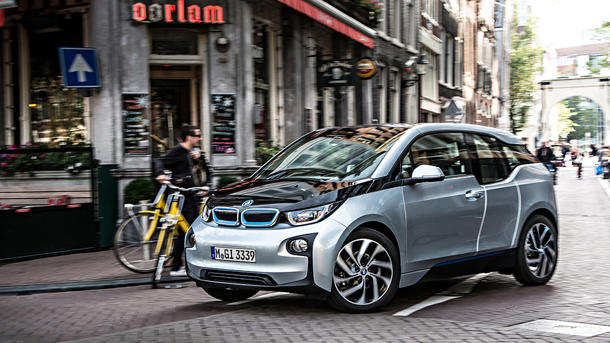
A rotund glasses-wearing man, proudly employed by the new i division of BMW, stood on a platform in front of a large photograph of some indeterminate European skyline. He looked quite self-satisfied, if a little nervous. For 15 minutes, he’d been moving around the room from one platform to another, like an actor in an awkward college staging of a Bertolt Brecht play.
“BMW i,” the man said, “heralds the dawn of a new age of electromobility.”
If history has taught us anything, it’s to be wary of Germans proclaiming “the dawn of a new age.” That said, the BMW i3, which enjoyed its international cotillion last week in Amsterdam, represents a substantial reimagining of how a car should drive, how we interact with our vehicles, and what, in general, a car should be. It’s a significant development in automotive history, and a remarkably nimble one given the size and pedigree of the company.
BMW formed “Project i” in 2007 under the care of Ulrich Kranz, the executive who’d overseen the rebirth of Mini and the highly successful launches of the X3 and X5 SUVs. The goal was to position BMW for the future by thinking of “sustainable mobility concepts.” An initial team of seven people began debating what the car of the future would look like: It had to run on alternative energy, it had to have a trendy modern design, it had to incorporate technology in an intelligent way, and, most of all, it had to suit the lifestyle of the world’s megacities.
Kranz and his team traveled to 20 metropolises, including London, San Francisco, Shanghai, and Mexico City, looking for tech-savvy upper-middle class people who either claimed to, or strived for, “sustainable lifestyles.” In other words, they sought out the BMW customer of the future. The result? An electric car of great quality and efficiency, and — this may be the key genius of the whole concept — made entirely out of materials recycled using renewable energy. As one BMW executive told me, “the next phase in premium is sustainability.” They know what their customers want; the i3 stands for a totally different approach, and may very well end up being the most significant car of its age.
The i3 presents small, and on the outside, it doesn’t look like much, maybe a slightly more chic version of “The Howard,” the electric-car MacGuffin from Larry David’s hilarious HBO movie "Clear History." There’s almost no hood, and the front grilled is framed, rather than with a showy roundel, by plastic slits that look suspiciously like a pair of Ray-Bans. It slopes up to a rear hatchback, and has four doors, though the rear coach doors, hidden almost like a Murphy bed, can only be opened if the front doors are open. At the moment, the i3 only comes in two colors, a fun-looking burnt orange, which will probably become its signature, and a less-fun-looking creamy silver.
Much of BMW's efforts has gone inside. The i3’s designers intended, BMW told us, to create a feeling of a “loft on wheels” that offers an escape from the stresses of city living. It’s made of recycled carbon-fiber and faux-wood paneling, like a tech startup office with an electric motor; all that’s missing is a white board and a ping-pong table. Because the car, essentially, doesn’t have a hood, the dashboard seems to extend forever. The front seats are perfectly poised, and the rear is a little cramped, but basically functional. There’s enough storage in the hatch for a few grocery bags, but the rear seats come down, creating room for whatever errands need to be done.
At its core, the i3 is a city-dweller’s car. BMW rode 32 million miles with megacity drivers, and they determined that the ideal urban pod dweller drives an average of about 35 miles a day. The majority of the world’s drivers spend the majority of their time driving in cities. “It’s not an aggressive way of driving,” a BMW executive told me, “but cooler driving. Drivers can have a calmer, more relaxing driving style.”
They engineered it as such, and the buzzwords match the experience. Driving the i3 was the most relaxing city-driving experience of my life. They gave it to us in Amsterdam, which isn’t as stressful to drive in as, say, Los Angeles or Calcutta, but it’s still a big city full of trams and trucks and scooters and thousands upon thousands of happy, tall, beautiful coat-wearing people riding bicycles. There were many obstacles. The i3 helped me drive around them with incredible precision and nimbleness.
Traditional categories like horsepower (there's 170 hp available from the i3's electric motor) dissolve with this car. The major operations are comprised of three components: a “one-pedal drive,” turning radius, and balance. Because of the regeneration grip dialed in by BMW engineers to recharge the batteries from motion, the car stops almost immediately when you take your foot off the accelerator. I drove the i3 for more than four hours over the course of two days, and used the brakes roughly twice. The i3 turns almost in a circle, making it easy to maneuver into tight parking spots and narrow alley-like streets. It has excellent poise, necessary for the small, sudden turns that urban driving often requires. It’s car operation as parkour.
The machine isn’t without its flaws. On my second-day test drive, when I moved it over cobblestone streets, the automatic doors kept locking and unlocking, and I couldn’t stop them. For a second there, the i3 felt like HAL 9000, turning psychotic and hurtling me toward oblivion. But other than that modest annoyance, driving it felt relaxing, calm, and even friendly, almost meditative.
BMW’s conception of the i3 as the ultimate hipster lifestyle car goes far beyond an approximation of driving Zen; they’ve designed it to be an extension of a modern digital reality. The i3 comes equipped with a suite of apps that actually work. It has a center-console screen with a somewhat above-average GPS, but it’s not a crummy iPad knockoff like the ones seen in so many contemporary cars. The real magic comes in the smartphone connectability; in particular, there’s an app that directs you to the nearest parking station with an electric charger and gives you an alternate route involving public transportation or even walking. This wouldn’t work in a city like, say, Houston, at least not right now, but it’s perfect in Amsterdam, which has more than 700 public charging stations within the city limits alone, or in a San Francisco of the very near future.
The i3 gets more than 80 miles per charge, and can totally refresh in six hours. The charging cable cleverly hides under the front hood, and it locks in place when you lock the car. So if you want to drive it all day, you can; there's also a version with a tiny motor borrowed from BMW's motorcycle unit that acts as a mini-generator, but BMW provided none of those to us for testing, pushing only the electric version instead.
So let’s address the 800-pound carbon-fiber gorilla in the room: The i3 almost seems to mock the concept of BMW as “the ultimate driving machine.” That said, it goes fast. Very fast. We never took the i3 over, say, 85 mph on the motorway, but it got there with amazing quickness, as though I were calling down to Scotty in the engine room and saying “warp drive.” The car gave a little whirr, and then we launched, awesomely, into the Delta quadrant. It rocketed us forward into a beautiful, noiseless, solar-powered future.
The i division now has 400 employees, and with the launch of the i8 sports car next year, it’s just going to keep growing. The i3 goes on sale in Europe in November, and will sell in the U.S. for a little more than $41,000, which is just about the cost of a tricked-out Chevy Impala. In other words, it’s not an inexpensive car, but it’s hardly beyond the reach of BMW’s core customer. It’s going to be hugely successful, and we’re going to have to change our conception of what a BMW car looks like.
The key to evolution, Charles Darwin taught us, is that the most successful species aren’t necessarily the smartest, or the fastest, but the ones that are most able to adapt to change. While the rest of the dinosaurs wonder about that bright light in the sky, BMW has evolved.

